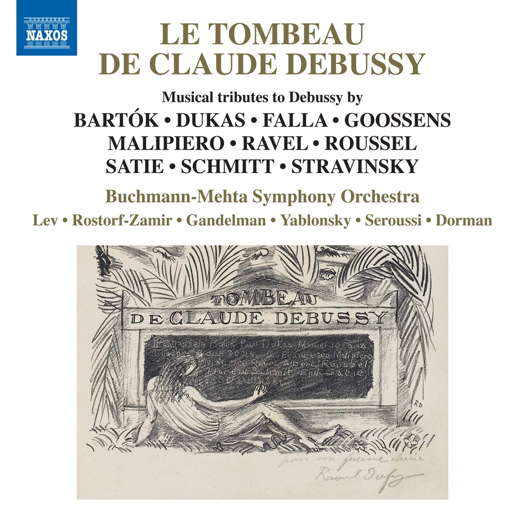- Antonio Salieri
- Mikhail Iosifovich Nosyrev
- Roger Smalley
- Anatol Liadov
- Jerome Rose
- Russia
- Antonio Lauro
- British Columbia
 DISCUSSION: John Dante Prevedini leads a discussion about Music and the Visual World, including contributions from Celia Craig, Halida Dinova and Yekaterina Lebedeva.
DISCUSSION: John Dante Prevedini leads a discussion about Music and the Visual World, including contributions from Celia Craig, Halida Dinova and Yekaterina Lebedeva.
 LISTENING TO TCHAIKOVSKY: Béla Hartmann uses his knowledge of Eastern Europe to argue against the banning of all Russian culture following Vladimir Putin's invasion of Ukraine.
LISTENING TO TCHAIKOVSKY: Béla Hartmann uses his knowledge of Eastern Europe to argue against the banning of all Russian culture following Vladimir Putin's invasion of Ukraine.

Saying Goodbye
Music in response to Debussy's early death, reviewed by GEOFF PEARCE
'The performances are great all round, and this is a useful addition to anyone's collection.'
This is a very interesting disc of recordings of pieces written in response to the early death of Debussy. The initiative was initiated by La Review Musicale, a Parisian musical magazine. The ten composers who responded were wide ranging, as are their musical styles, but all were profoundly influenced by Debussy.
The first work on the disc is La plainte, au loin, du faune ... by Paul Dukas, and is Dukas' last piano work as he had basically retired from composition. This quite introverted five minute work looks at the death of Debussy from the point of view of the faune mourning the death of his creator. Various melodic elements drawn from the Debussy work are explored in this rambling and touching work. The pianist on this and the next eight tracks that make up the bulk of this collection is the excellent Tomer Lev. His playing has clarity and gravity, and is full of pathos.
Listen — Paul Dukas: La plainte, au loin, du faune ...
(track 1, 1:17-2:03) ℗ 2020 Naxos Rights (Europe) Ltd :
Homenaje by Manuel de Falla (which also ends the disc in a guitar version which was the original conception) is in a habanera rhythm containing relatively little melodic material, based on a falling interval to give the feeling of sighing and lamenting. This work is strongly influenced by the Andalusian Cante Jondo, a style which fascinated Debussy and which was used as a basis for many of Debussy's Spanish flavoured works. It quotes from Debussy's La Soirée dans Granade.
The third work is by Florent Schmitt, a particularly favourite composer of mine. À la mémoire de Claude Debussy: et Pan, au fond des blés lunaires, s'accouda (No 1 from Mirages, Op 70) is quite a long work at just over seven-and-a-half minutes. It uses a variety of styles, at some stages romantic and at others, pseudo impressionistic. A wide range of moods is thus presented, at times hypnotic, at others tender, and at times dramatic and virtuosic. This work, I think, reflects back over the feelings Debussy's music evokes rather than mourning his departure. The final section is, in my imagination at least, Debussy's soul saying goodbye to this earthly plain.
Listen — Florent Schmitt: À la mémoire de Claude Debussy
(track 3, 6:22-7:33) ℗ 2020 Naxos Rights (Europe) Ltd :
The song À la mémoire de Claude debussy - en souvenir d'une admirative et douce amitié de trente ans: Que me font ces vallons by Eric Satie is basically two phrases inspired by the poem l'Isolement (Isolation) by August de Lamartine. The singer here is Sharon Rostorf-Zamir, who interprets it beautifully.
Gian Francesco Malipiero's very short and touching Hommage à Claude Debussy is inspired by Debussy's love of archaic medieval music. In places the music is reminiscent of Debussy's La cathédrale engloutie.
Listen — Gian Francesco Malipiero: Lento (Hommage à Claude Debussy)
(track 5, 1:29-2:13) ℗ 2020 Naxos Rights (Europe) Ltd :
The next work is a chorale drawn from Symphonies for Wind Instruments, which Igor Stravinsky was writing at the time, specifically for this collection. The composer later dedicated the complete Symphonies to Debussy.
This is followed by Eugene Goossens' Hommage a Claude Debussy Op 28. It contains two short pieces, the first in the style of Berg and Schoenberg, and the second in a more impressionist vein.
Bartók's contribution was later incorporated into his Hungarian Peasant songs. He was, for a time, strongly influenced by Debussy, particularly by Debussy's harmonies, which at the time were considered quite rebellious.
Albert Roussel's L'accueil des muses 'In memoriam Debussy' pays homage to Debussy's interest in Classical Greece. The work gradually climbs as if reaching the summit of Mount Parnassus, the seat of the muses in Classical Greece.
Listen — Albert Roussel: L'accueil des muses 'In memoriam Debussy'
(track 9, 2:46-3:32) ℗ 2020 Naxos Rights (Europe) Ltd :
For the original compilation, Maurice Ravel wrote a five minute single movement, but later expanded this into a four movement sonata for cello and violin. At times the music is reminiscent of Bartók and Kodály. (Kodály wrote a similar work for both instruments.) Like many of Ravel's later works, there are sometimes elements of jazz to be found and the music is witty and sophisticated. The sonata receives a very fine performance by Janna Gandelman on violin and Dmitry Yablonsky on cello.
Listen — Maurice Ravel: L'accueil des muses 'In memoriam Debussy'
(track 10, 2:54-3:40) ℗ 2020 Naxos Rights (Europe) Ltd :
This is followed by the complete Symphonies of Wind Instruments of Igor Stravinsky, as mentioned earlier. The performance by members of the Buchmann-Mehta Symphony Orchestra from Tel Aviv University is fine and detailed, and I enjoyed it very much. Conductor Zeev Dorman's direction of this tricky score was exemplary.
Listen — Igor Stravinsky: Symphonies of Wind Instruments
(track 14, 5:35-6:26) ℗ 2020 Naxos Rights (Europe) Ltd :
The final track is the original version of the De Falla work which came second on this disc. This is scored for guitar and I liked this version better, as the guitar seems to accentuate the Spanish flavour. The recording here is by Ruben Seroussi, a very fine player who employs a wide range of colours and is clean in his fingerwork.
Listen — Manuel de Falla: Homenaje
(track 15, 0:00-0:45) ℗ 2020 Naxos Rights (Europe) Ltd :
This is an interesting collection of somewhat neglected works, and I hope this spurs interest in them. The performances are great all round, and this is a useful addition to anyone's collection.
Copyright © 6 March 2021
Geoff Pearce,
Sydney, Australia

CD INFORMATION: LE TOMBEAU DE CLAUDE DEBUSSY
CLASSICAL MUSIC ARTICLES ABOUT FRANCE


